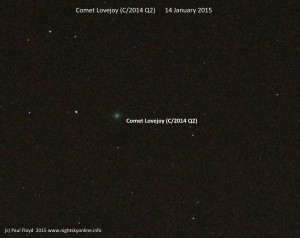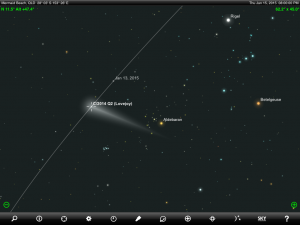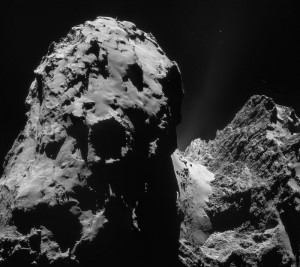(Posted 15 January 2015) Comet Lovejoy (C/2014 Q2) continues to be easily visible above our North East horizon at the end of evening twilight in binoculars, and will do so for the next few weeks. If you haven’t looked at it already, do so as it is likely to be 2015’s brightest comet.

The green colour of Comet Lovejoy (C/2014 Q2)’s coma (see above image) was easily visible in my large binoculars at the time of preparing this post. It is caused by diatomic Carbon gas being released by the comet’s nucleus fluorescing (or ‘glowing’) in response to the ultraviolet radiation being emitted by the Sun. Use this colour to assist you in locating the comet. Very few astronomical objects display colour and this will help you distinguish the comet from any other astronomical object your binoculars happen to wander across.

If you are not familiar with hunting for faint and fuzzy objects with binoculars, firstly get away from street lights. The comet is bright by astronomical standards (magnitude 4 at the time of preparing this article) but not by casual sky watcher standards. Use the above wide angle chart to initially orientate yourself.

Once you have orientated yourself, use the above more detailed chart and binoculars to look for a faint fuzzy blob with a greenish tinge to it. The comet won’t display the tail visible in the chart. Note that the comet is going to get fainter as it moves away from the Earth and moves lower on our Southern horizon. Now is the time to dust off your binoculars and look for your first comet.

What you won’t be able to see in your view of Comet Lovejoy (C/2014 Q2) is what gets amateur astronomers excited. At the heart of Comet Lovejoy (C/2014 Q2) is a gigantic dirty iceberg in space – erupting vast quantities of gas and dust (to a much lesser degree) into space. Close up views of another comet (see the above example) are currently being provided by the European Space Agency’s Rosetta Spacecraft.
Comet Lovejoy (C/2014 Q2) was discovered by Australian amateur comet hunter Terry Lovejoy in August 2014 and was closest to the Earth on 7 January 2015 at 70 million kilometers away.
1 thought on “Where to look for C/2014 Q2 (Lovejoy) 15 – 28 January 2015”